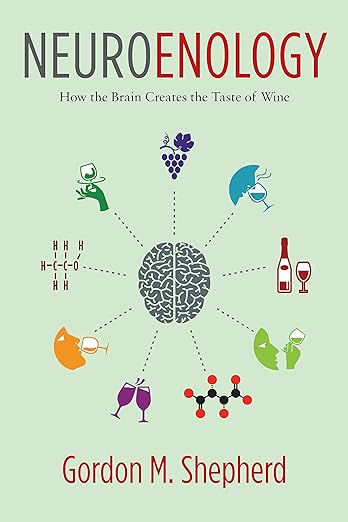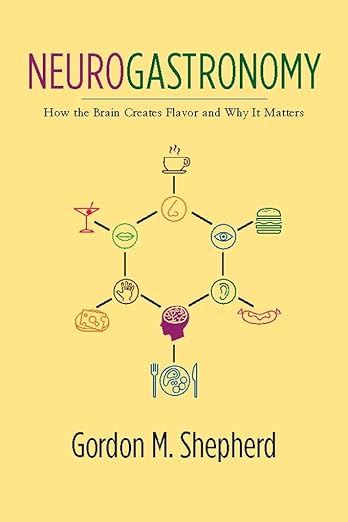BNA Annual General Meeting 2025
1st April 2025
27th Nov 2023

 BNA associate member, Brenda Walker, shares her review of the books 'Neuroenology, How the Brain Creates the Taste of Wine' (2017) and 'Neurogastronomy, How the Brain Creates Flavor and Why it Matters' (2012), by Gordon M. Shepherd.
BNA associate member, Brenda Walker, shares her review of the books 'Neuroenology, How the Brain Creates the Taste of Wine' (2017) and 'Neurogastronomy, How the Brain Creates Flavor and Why it Matters' (2012), by Gordon M. Shepherd.
If you are not a neuroscientist, you may never have heard of the inspirational American author of these two volumes. However, Gordon Murray Shepherd, born in 1933, had a very distinguished career, and at the time of his death in the summer of 2022, was still playing an active role as professor emeritus at Yale School of Medicine. He was considered not only to have played a founding role in the sub areas of computational science and neuroinformatics, but also in the field of cognitive neuroscience. He built on his graduate discoveries of how neurons in the brain use microcircuits to carry out the functional operations of the nervous system and was especially renowned for his research into the olfactory bulb microcircuit. By taking this route in his early years he helped provide the basis for much of our ongoing knowledge about how the brain functions.
The titles of these two books were coined by Shepherd, and their content has a clear purpose: to change the common view about the origin of taste and flavour.
‘A common misconception is that the foods contain the flavors; foods do contain flavour molecules, but the flavor of those molecules are actually all created by our brains.’
He explains that the unique flavour system that humans possess is not the weakest but ‘the most extensive behavioural system in the brain’ as it can create memories, perceptions, emotions, language, consciousness, and decisions; all of which can all be initiated by flavour. He goes on to say that evolution has led to years of patterns of activity constructed by the smell pathway now forming the basis of the perception of smell via smell molecules.
Shepherd states he was encouraged to follow his first publication on food and drink with one on wine, not only by friends and distinguished colleagues, but also by the great French scientist and philosopher, Jean-Didier Vincent and many other French wine experts. As one might expect, both books are well planned with key elements of chapters explained in the introductions so a lay reader is well versed as to what to expect.
Shepherd’s last book, Neuroenology (‘Enology’ being the study of wines), uses the analogy of ‘five steps’ in his approach to educating the reader. All are detailed in the introduction on pages 2 and 3, which he summarises as follows:
‘Neuroenology will enlarge your appreciation for how extensively you and your brain are involved in the taste of wine you drink. I hope you will understand a little better the claim we made at the start: the taste of wine is not in the wine but in your brain. Welcome to a fabulous world of wine: inside your head. To paraphrase the Bard, “Oh brave new world, that has such brain cells in it!’
There are twenty chapters divided into three parts: Fluid Dynamics of Wine Tasting/ How Sensory Systems Create the Taste of Wine/How Central Brain Systems Create the Pleasure of the Taste of Wine. The first chapter introduces fluid biomechanics, a term described as ‘the movement of liquid through a physical space in the body’ and ‘the dynamics of wine through the mouth’ together with ‘the movement of air through the nose and throat’. Both books illustrate how the brain creates the actual taste or flavour as the molecules arrive at the sense cells in our noses when we exhale. The author explains this when he writes of the retronasal or internal smell released when we eat or drink, producing the illusion of taste. Smell is apparently with us at birth, but individual differences are born through retronasal smell. The brain also creates the colour as it responds to ‘unique combinations of sensitivities’ for any wavelengths of light. Shepherd recalls that much has been written about the flavour of food and wine, but little about the involvement of motor control and muscle side of wine tasting. He rectifies this in great detail throughout when in the following chapters he discusses the pathway, the tongue, swallowing and the sensory systems.
The final chapter describes elements of his lifetime of research when lecturing on both sensory physiology and smell, and an appendix follows with a detailed wine tasting tutorial with Jean-Claude Nerrouet, the chief wine maker and technical director for Chateau Petrus in Bordeaux for over forty years.
Rather than ‘steps’, Neurogastronomy has four parts but twenty-seven chapters that set out the ‘key elements of the new science of flavor’ in relation to food. This book explores flavour as a force in human history and has many anecdotes and quotations scattered throughout the volume, including literary quotes from Moliere’s Le Medic, T.S. Eliot’s Four Quartets, Shakespeare’s As You Like It and Proust’s Swann’s Way. The latter quotation leads into a chapter on ‘Flavor and Memory’ continuing with a section on smell, emotion and memory, where he comments on the challenge in finding the right language to characterise complex images with vision and hearing, even in art forms like the cubism period of Picasso.
A volume full of surprises, Shepherd analyses biological differences between dogs and humans; describing the dog’s adaptation for retronasal smell as ‘an engineer’s dream’. His section on interactions of Touch with Taste and Flavour is particularly interesting as are his comments on the other senses, muscle movement, and emotions that create ‘images of desire’; all summed up as the ‘human brain flavour system’ forming the heart of neurogastronomy.
Both books provide fine clearly labelled illustrations, indices and a bibliography (in which he acknowledges other authors involved in writing on the same topics). Even though the prose of both books is sometimes dense with important factual information and much academic terminology, it is not too difficult for those on the periphery of science to understand. So, if you want to know how the brain creates pleasure; some fascinating rules for balancing the Taste, Aroma and Texture of food and wine; tips for wine-tasters; why we overeat or become obese; why we like some foods more than others; what happens when you are recalling a special meal or how wine-tasters develop the skill of selection, it is well worth reading both these interesting books.
Brenda Walker
January 2023